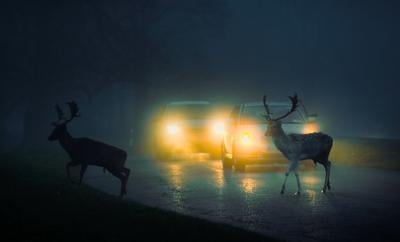In 2022, more than 7,000 animals were killed by vehicles on Colorado's roads. While it can be easy for drivers to take the 'it won't happen to me' approach when it comes to wildlife collisions, it's always best to be prepared and to know what to do if a strike seems imminent.
Part of being prepared is knowing what areas tend to be at risk when it comes to wildlife collisions, as well as what times to day to be particularly cautious.
As noted by the Colorado Department of Transportation, animal collisions can happen year-round and 24 hours a day. Dawn, dusk, and at night when visibility is low can be times of the day when drivers are most at-risk, with the average property damage cost from a strike estimated at more than $3,000 per incident.
In general, any winding road where blind turns exist tend to be problematic, especially when these roads are in forested areas. Roads without a clear view of the space immediately off the pavement or where this space is covered by foliage can also be dangerous. Agricultural lands can also be a place where wildlife is ample.
Outside of general types of roads to watch out for, Colorado Parks and Wildlife has also published a list of eight routes around the state that have proven to be particularly problematic.
Here's the CPW list of roads where the risk of wildlife collisions tends to be elevated:
- Interstate 70 (Floyd Hill, Mt. Vernon Canyon and Eagle)
- US 285 (Morrison)
- Highway 160 (Durango to Pagosa Springs and Durango to Mancos)
- Highway 550 (north of Durango and from Montrose to Ouray)
- Interstate 25 (Castle Rock to Larkspur)
- Highway 82 (Glenwood Springs to Aspen)
- Highway 36 (Boulder to Lyons)
- Highway 93 (Golden to Boulder)
The best way to prevent a wildlife collision is by driving slower and only operating a vehicle while alert, free of other distractions like a cell phone.
That being said, if a collision seems imminent, the three options are basically to slow or stop, to swerve, or to prepare for an animal strike.
Slowing or stopping can be a great option if there's time and space to do so – but realize, on a crowded road, this could put other drivers at-risk and you might get rear-ended. Slamming on the brakes can also cause a skid. This makes it crucial to only consider this option when it can be done in a safe and controlled manner.
A second option is swerving, which is generally not advised. Not only does swerving at a high speed mean potential loss of control, it can also mean a risk of a head-on collision if lane lines are crossed.
The third, and often (and unfortunately) the safest option is to brace for impact. If you're unable to safely slow down and a swerve would put you at risk, you'll want to firmly apply the brakes and slightly adjust your vehicle for the area where the animal came from, not where they're headed. As you're about to strike the animal, let off of the brakes slightly to raise the front of your vehicle. This can prevent the animal from coming in through the windshield.
If you strike a large animal, call local law enforcement immediately to report the accident.
No one wants to think about the possibility of killing an animal with their vehicle, but considering options ahead of time can make it easier to react in the heat of the moment. And remember, the best way to prevent a collision is by controlling your speed.
STAY INFORMED: Get free Colorado news with our daily newsletter (Click here)







(0) comments
Welcome to the discussion.
Log In
Keep it Clean. Please avoid obscene, vulgar, lewd, racist or sexually-oriented language.
PLEASE TURN OFF YOUR CAPS LOCK.
Don't Threaten. Threats of harming another person will not be tolerated.
Be Truthful. Don't knowingly lie about anyone or anything.
Be Nice. No racism, sexism or any sort of -ism that is degrading to another person.
Be Proactive. Use the 'Report' link on each comment to let us know of abusive posts.
Share with Us. We'd love to hear eyewitness accounts, the history behind an article.